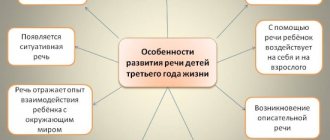Most often, speech disorders are detected at the age of 3 years, when the child begins to actively speak. Using a real example, we tell you what general speech underdevelopment (GSD) is in children, whether it is a dangerous diagnosis or not, and how you can help your child speak at home.
⠀
Speech development disorders can occur in children raised in ordinary families, and in children from bilingual families, i.e. in congenital bilinguals, when the child’s parents speak different languages.
⠀
Young bilingual children learn two languages from early childhood - the first, the main language, and the second, which is spoken less often. Therefore, speech problems in such children are most often associated with incorrect pronunciation of sounds and mixing of languages in speech.
⠀
From this article you will learn:
- what is general speech underdevelopment (GSD) in children;
- Is this diagnosis dangerous or not?
- in what cases should you sound the alarm;
- what specialists to contact;
- How can you help your child speak at home?
⠀
To make it clearer for you, we will analyze all the questions using a real example.
My child does not speak, is silent, speaks little, speaks poorly!
At the Sarclinic consultation, parents ask: “Why doesn't a 3 year old child speak or talk?, what to do?" " A 4-year-old child speaks poorly and is silent!” “Why doesn’t a boy speak for 5 years, where should I go?” “A 6-year-old girl does not speak, speaks poorly, how to treat?” " Why does a child speak poorly? or speaks few words? " How to teach a child to speak, talk?" “What to do if a preschooler, schoolchild, boy, girl does not speak in sentences, as if he has porridge in his mouth?” “How to help a child if speech development suffers, there is no active speech, speech centers suffer, and there is no vocabulary?” “Children younger than us form sentences, and we moo, where should we turn if just mooing is all?” “When will the baby start talking?” Let's look at the main reasons why babies don't speak.
Recommendations for parents
Children aged three years old know most objects or their purpose. Therefore, parents need to say the name of unfamiliar objects and explain what they are needed for. In addition, the following exercise is useful for developing vocabulary, grammatical structure and coherent speech: select one subject and describe it. After some time, ask your child about this item. You need to ask questions in such a way that the child gives detailed answers.
Look at books with illustrations together and tell them what is depicted there. You can practice retelling short fairy tales - only they must be accompanied by pictures. During the retelling, ask leading questions that will already contain part of the answer.
After reading a fairy tale, ask for opinions: which hero did you like, why, what was the fairy tale about, what was most memorable. This is a good way to develop grammatical structure and coherent speech.
While walking, look at the surrounding objects, train your counting skills and describe nature (flowers, trees, animals, birds). Answer every question asked, but the sentences should not be difficult for children to understand. An adult’s speech should be understandable, pronounce sounds clearly, and while reading, use intonation to convey the characters’ personalities.
At this age, be sure to play role-playing games. They not only develop imagination, but also improve coherent speech. During such games you can expand your vocabulary. For example, explore new types of clothes, shoes or furniture. Role-playing games are suitable for training diction and expressiveness of speech.
The main task of parents is to encourage children's speech activity and develop social skills. It is at this age that language is not just a tool for understanding the world, but also a way of interacting with people.
Reasons why a child does not speak
The main reason why a boy or girl, son or daughter, son or daughter, son or daughter (daughter), a child does not speak is intrauterine hypoxia, or lack of oxygen. Lack of fetal oxygen can occur during pregnancy, during childbirth, and during caesarean section. In this case, an experienced microneurologist , pediatric neurologist , pediatric neurologist makes a diagnosis of “perinatal encephalopathy of post-hypoxic-ischemic origin” or “perinatal encephalopathy of mixed origin” (perinatal damage to the central nervous system). Perinatal encephalopathy can be grade 1, 2, 3.
Stage 1 perinatal encephalopathy with timely and comprehensive treatment at Sarklinik is completely cured in a fairly short time. Stage 2 perinatal encephalopathy is a serious disease that requires long-term serious treatment. Stage 3 perinatal encephalopathy usually has serious consequences, including the development of pathology such as cerebral palsy. Frequent causes of delayed speech development in children are pathology of the mother during pregnancy, birth trauma of the child, difficult childbirth, poor results of neurosonography, entanglement of the umbilical cord, breech presentation of the fetus, weakness of labor, anatomically or clinically narrow pelvis, somatic diseases of the mother before and during pregnancy, maternal infections, fetal infections, toxic effects on the child's brain of bilirubin in hemolytic jaundice of the newborn (HDN), intoxication with anesthesia during cesarean section, intoxication with drugs (drugs) in the perinatal period. Any somatic pathology, ARVI, bronchitis, tracheobronchitis, infections, rickets, metabolic disorders lead to the fact that at a later age the child does not speak , the child speaks poorly , the child speaks little , the child is silent , begins to speak late, speaks little, is not clear , incomprehensible, retarded in development, retarded in speech, mental, psychomotor, psycho-speech development, mental development.
There is RRD (retardation, delayed speech development, including severe delay in speech development), ZPR (lag, delayed mental development), ZPRR (delayed psycho-speech development in children), PMR (delayed psychomotor development in a child), ZUR (mental retardation). development in children). Rarely, a child is influenced by hereditary factors in which developmental delay was observed in the mother or father, or in both. Any weakening of the child’s body, decreased immunity, side effects of vaccinations (vaccines) can lead to the fact that “ the child does not speak .” Also, a child’s speech development is negatively affected by an unfavorable environmental situation in the area where the mother and child live, an unfavorable climate in the family (conflicts between parents), defective, unclear speech in a contact environment (speech problems among relatives or parents), the birth of a second child in the family, the presence of severe severe neurological diseases (for example, cerebral palsy). With delayed motor development, there is often a delay in speech development, and later a delay in mental development. With any damage to the organ of hearing, a condition in which “ the child does not speak ” is also noted. In this case, you need to consult an otolaryngologist (ear-nose-throat-doctor).
What to do if the child does not speak?
Many parents turn to a speech therapist with this question. But a speech therapist can make sounds, the letters “r”, “l”, “sh”, “shch”, hissing, if the child can respond to classes. A speech therapist is a teacher, not a doctor. With hypoxic lesions of the brain and central nervous system, the speech therapist is powerless. In these cases, complete comprehensive speech rehabilitation of the child is needed. Unfortunately, some careless parents, mothers and fathers wait for the child to speak on his own and naively think that he is being lazy. But we must not forget about the norms of speech development. At 1 year old, a child should speak 10 words, at 2 years old – 50 words, build phrases and sentences from 3 – 4 words. By the age of 2.5 years, a child normally speaks from 100 to 200 words and constructs sentences of 5 to 7 words. At 3 years old, a child absorbs the words of adults like a sponge, should already speak in complex sentences of 6-8 words, and at 4 years old, the vocabulary should already be about 2000 words.
Children's gatherings
Children always strive to imitate adults. It's so much fun to wear mom's shoes or fix a faucet like dad! Receiving guests is also very important, interesting and adult-like.
Let's have a children's party! Invite friends with well-spoken children, neighbor kids from the playground. In a home environment, it will be easier for the baby to relax and start talking. The main thing is not to impose communication norms on your child: “Say hello to your aunt,” “Tell the boy,” etc. The purpose of children's gatherings is to create conditions when the child needs to talk. Children watch other peers talk to each other, and then learn to repeat after them, name objects and act out adult situations.
The earlier treatment for speech disorders is started, the higher its effectiveness.
When speech development is delayed, an important point is the time of initiation of treatment. If a child does not speak 10 words per year, then there is no need to wait until he is 7 years old when he “starts speaking on his own.” After all, precious time is wasted. The later treatment is started, the more difficult it will be to catch up with healthy children of the same age, since with increasing age the lag will become noticeably larger and larger. Some children, when their parents address them, understand the speech addressed to them, but do not respond, there are only gestures. Some children do not understand the spoken language and do not speak. Which is very bad. And if children speak little, indistinctly, then speech correction is needed.
Examples of techniques and exercises
There are many methods and exercises for developing speech at home. It is important to select them in accordance with the child’s age and goals (that is, what exactly you want to shape or adjust).
"Third wheel"
Goal: developing the skill of generalization, the ability to establish connections between subjects, verbal justification of the answer.
An adult shows pictures of four objects. You need to determine which one is superfluous and explain why. If there are difficulties with the answer, the adult asks leading questions. Objects must be understandable to the child.
"Who is speaking?"
Goal: to teach to recognize onomatopoeia in animals, to correlate an adult animal and a baby.
Choose appropriate visual material depicting animals. Ask who is drawn there, ask them to depict how this animal talks. Find out the names of the cubs. Before carrying out the task, you can repeat the animals.
"Tell me which one"
Goal: to teach how to identify and name the characteristics of an object.
An adult shows a picture of an object and asks to name the main characteristics (color, size, shape, taste).
"Confusion"
Goal: to teach how to find errors in familiar phenomena and name them.
An adult shows a picture with inaccuracies: a red hare eats chocolate, a bear flies, a fish lives in a hollow, and other similar images. The child must correct mistakes and say what should be correct.
Treatment of children with delayed speech development, how to treat children with speech disorders
Fortunately, Sarklinik has treated hundreds of children with delays in speech, psycho-speech, mental, motor, and psychomotor development. Treatment of alalia, treatment of dyslalia, treatment of general speech underdevelopment, treatment of dysgraphia, treatment of acalculia, treatment of encopresis, treatment of perinatal encephalopathy, treatment of tone disorders, treatment of akataphasia, treatment of akatagraphy, treatment of intracranial hypertension syndrome, treatment of dyslexia, treatment of autism, treatment of cerebral palsy, treatment are provided. enuresis, treatment of minimal cerebral dysfunction in Russia, in the Saratov region, in Saratov. Sarklinik knows how to teach a child to speak, how to treat and cure a child, how to treat delayed speech development in a child , how to treat delayed psycho-speech development in children, how to cure delayed neuropsychological development, how to give impetus to speech development, how to replenish vocabulary, how improve speech. Treatment methods have proven themselves over the years. Severe, moderate, and mild delays in psycho-speech development, and mental retardation are treated. Sarclinic works with serious diagnoses, when parents have less and less hope for recovery. Unfortunately, in such cases, as a rule, multiple courses of complex treatment are required, as a result of which memory, thinking, speech, mental development, motor sphere, and motor activity are improved. There is extensive experience in treating children with pediatric pathologies aged from 3 months to 17 years. There are plans to publish a video course “ How to teach a child to speak ?” On the medical website sarclinic.ru you can ask a doctor a question online for free and read patient reviews. Help your child right now!
There are contraindications.
Specialist consultation is required. Sign up for a consultation .
Text: ® SARCLINIC | Sarclinic.com \ Sarlinic.ru Photo: (©) Hyrman | Dreamstime.com \ Dreamstock.ru The child depicted in the photo is a model, does not suffer from the diseases described and/or all similarities are excluded.
Related posts:
Which clinic best treats nocturnal enuresis in children in Russia
Speech Correction Center, Central Clinical Hospital Sarclinic Saratov, speech development center, correction of speech disorders
Nocturnal enuresis, sleep enuresis, bedwetting, treatment, enuresis in children, in adults
What is the proper weight (body weight) and height of a child by month, year: table, norms
Neurosonography of the brain of newborns: norms, interpretation, center, where to do it










